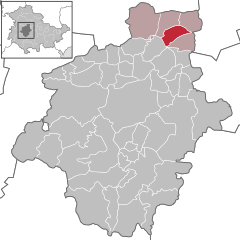Großfahner
| Großfahner | ||
|---|---|---|
| ||
 Großfahner | ||
Location of Großfahner within Gotha district 
 | ||
| Coordinates: 51°4′0″N 10°49′0″E / 51.06667°N 10.81667°ECoordinates: 51°4′0″N 10°49′0″E / 51.06667°N 10.81667°E | ||
| Country | Germany | |
| State | Thuringia | |
| District | Gotha | |
| Municipal assoc. | Fahner Höhe | |
| Government | ||
| • Mayor | Karin Schneider | |
| Area | ||
| • Total | 11.41 km2 (4.41 sq mi) | |
| Population (2015-12-31)[1] | ||
| • Total | 821 | |
| • Density | 72/km2 (190/sq mi) | |
| Time zone | CET/CEST (UTC+1/+2) | |
| Postal codes | 99100 | |
| Dialling codes | 036206 | |
| Vehicle registration | GTH | |
| Website | www.vg-fahner-hoehe.de | |
Großfahner is a municipality in the district of Gotha, in Thuringia, Germany.
The town is known to music historians due to the 600 manuscripts from 1650-1750 copied by the church music director of the period - these include cantatas from forgotten Kleinmeistern such as Buttstedt, Friedrich Erhard Niedt, "Liebhold," Georg Friedrich Künstel and Johann Topf, as well as the only surviving copies of works by masters such as Pachelbel and Telemann.
References
This article is issued from Wikipedia - version of the 8/27/2016. The text is available under the Creative Commons Attribution/Share Alike but additional terms may apply for the media files.
